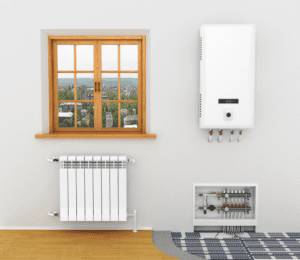Many business owners grapple with the significant costs of using HVAC systems to provide a comfortable experience for their employees and customers. Depending on the local climate, this can be a difficult task, so it takes having central heating systems explained to make an intelligent, informed decision about the heating and air quality.
Consider the questions to which you should know the answers before committing to a new central heating system: What kinds of systems are there? How powerful should my system be? What type of fuel source will I use? Once you know the answers to those, you can call an HVAC specialist for more information on specific makes and models that suit your needs.
Making the Right Choice for Your Business: Types of Systems
 Depending on whom you ask, you’ll get various numbers for the different kinds of central heating systems that businesses tend to use. For expediency, we’ll consider the three major styles of heating: forced air, radiant, and heat pump. In each case, there’s a central system that generates or gathers the heat, then additional components that distribute it throughout the building.
Depending on whom you ask, you’ll get various numbers for the different kinds of central heating systems that businesses tend to use. For expediency, we’ll consider the three major styles of heating: forced air, radiant, and heat pump. In each case, there’s a central system that generates or gathers the heat, then additional components that distribute it throughout the building.
Forced air is the most common method for businesses today. The central system involves burning either oil or gas to heat air, which is then distributed through a ventilation system to the entire building. One advantage of this style is the ability to use the same ductwork both for heating and cooling, letting you piggyback an air conditioning system onto the same network of ducts to reduce installation costs. If your business sees a lot of traffic entering and exiting through doorways, this can result in a significant amount of wasted heat, meaning your system will have to work swiftly to counteract this, which forced air can.
Radiant heat is another alternative, mainly suited to businesses that may not experience the same level of customers coming in and out of the business. Radiant heat is neatly tucked out of sight by heating rooms through heating elements in the floor or walls to distribute heat from the boiler evenly. It lacks the speedy punch of forced air but instead provides an efficient and gradual heat that may also be softer on your employees’ skin compared to the dry heat of a forced air furnace.
For the more temperate areas, heat pumps offer an efficient solution to your heating and cooling needs. As with forced air, some of these systems also involve ducts, but the installation of these ducts tends to be more expensive. If you don’t need the power of forced air, heat pumps will amaze you with the energy efficiency of moving heat from the outside to the inside. Rather than burning fuel to generate heat, heat pumps instead use electricity to trap ambient heat and send it where it is more useful.
Central Heating Systems Explained: Understanding Building Load
Another major component in having central heating systems explained is appreciating the impact that building load has on HVAC systems. A smaller location will not need nearly so powerful a heater to keep at temperature. On the other hand, a more substantial building even in a temperate climate may need a powerful forced air heater to manage the temperature variance between the seasons properly.
Many variables go into determining your exact building load, but the result is that having a building load number to work with can inform you as to how powerful a heater you’re obliged to get. If you install one that is too weak, your customers and employees will be hot in the summer and cold in the winter. If you install one that is too strong, you will spend extra money and run your system inefficiently. Contact an HVAC specialist for help to determine your building load.
Acknowledging the Costs: Fuel Source and Installation
The last major consideration about the distinctions between commercial heating systems’ functionality is the fuel source that already exists in your business, and what installation requirements there are. For any new system, there will be significant costs to install the necessary infrastructure. The ductwork for forced air and heat pump systems can be a considerable expenditure and may be limited by the existing structure of your business. In those cases, the pipes for radiant heat may be better, but will still have a significant cost attached to them.
Regarding the fuel source, forced air systems can use either gas or oil. If your building has neither, you must select a heater that uses electricity. Baseboard heating, heat pumps, and electric resistance heaters are all options, but the other aspects of your business will determine which is the best fit for you.
Finding the Balance for Your Business
Ultimately, each of the different types of heating systems offer advantages and disadvantages to businesses. The amount of work needed to determine the best solution can be overwhelming if left on your own. Fortunately, you don’t have to rely on yourself. Conduct the initial research here so you know which questions to ask, then find a local HVAC specialist who can assist you with finding the right system.

